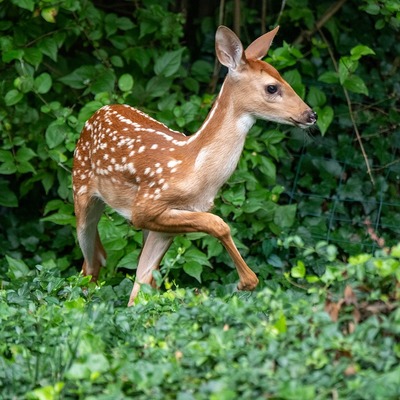Reminder: If You See A Fawn, Leave It Be
Friday, July 2nd, 2021 -- 8:00 AM

As the start of summer brings more opportunities to enjoy the great outdoors, the Wisconsin Department of Natural Resources reminds Wisconsinites and visitors of the possibility of encountering white-tailed fawns.
As we approach Independence Day weekend, most deer rehabilitators have filled their capacity to take on new fawn patients, making it more important than ever to know what to do if you find a fawn in the wild.
In almost every case, the fawn is doing exactly what it should. In the first few weeks of life, fawns stay quiet and hidden while their mothers look for food nearby. Their spotted coats and low scent are their best defenses in the first few weeks of life.
While fawns can walk from birth, they need a few more weeks to grow fast enough to keep up with their mothers and avoid predators. By the Fourth of July, most fawns are on the move alongside or nearby their mothers.
Mother deer still spend most of the day away from their fawns while they forage for food. Fawns lie still in brush or grass, keeping quiet until their mothers return, but now they have the speed and agility to run from danger.
Fawns have very specialized diets and can easily become dependent on people (habituated) for food, making release into the wild impossible. Holding any wild animal, including a fawn, for more than 24 hours is illegal in Wisconsin and can result in a citation with a monetary fine.
The 24-hour grace period is allowed for transporting an injured or sick animal to a licensed wildlife rehabilitator without delay. It is rare that unaccompanied fawns have been abandoned. If you find a fawn lying alone unless the fawn is sick or injured, leave it alone.
Leave the area and do not go near the spot again. The mother will not return if people or dogs are present. Do not touch the fawn or bring children, dogs or friends to look at it.
Doing so could endanger the fawn by giving away its location to a predator, and its mother won't return to nurse the fawn while people or dogs are nearby. If you find a fawn lying quietly in brush, high grass or even your lawn, the fawn is most likely healthy and safe.
If you are concerned, monitor the fawn from a distance. Its mother will return periodically to feed and move it to a new location. If a fawn is in an unsafe location, such as near a roadway, it’s okay to move the fawn back from the road several yards.
Be sure to wear gloves and a facemask to protect the health of the fawn, and be sure to consider your own safety when walking near a road. If a fawn appears visibly sick or injured, call the DNR or a licensed wildlife rehabilitator for further guidance.
Visit the DNR website for contact information for a county near you.
Feel free to contact us with questions and/or comments.




